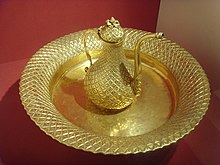Tombac
In older use, the term may apply to brass alloy with a zinc content as high as 28–35%.
[1][4] The term tombak is derived from tembaga, an Indonesian/Malay word of Javanese origin meaning 'copper'.
[citation needed] Tembaga entered Dutch usage concurrent with their colonisation of Indonesia.
Likely, the term was used generically to describe Indonesian high-copper brass items, including gamelan gongs.
Ure notes the following forms of tombak in widespread use during the time the text was published (1856):[5] Piggot states the brass used for machinery and locomotives in England was composed of copper 74.5%, zinc 25%, and lead 0.5%, which would make it a tombac according to Ure.

